Culture
A Brief History Of How Ganesha Hymns Elevated And Enriched Tamil Literature And Culture
Aravindan Neelakandan
Sep 07, 2024, 02:21 PM | Updated Sep 13, 2024, 05:58 PM IST
Save & read from anywhere!
Bookmark stories for easy access on any device or the Swarajya app.
.jpg?w=610&q=75&compress=true&format=auto)
.jpg?w=310&q=75&compress=true&format=auto)
Ganesha or Pillayar as He is fondly called is a God so loved in Tamil Nadu.
Tamil Nadu came up with the 'Pillayar Suzhi' which resembles the alphabet 'U' and it is made before starting any new venture - even writing a letter.
In terms of number of shrines, those of Ganesha number higher than that of any other Divine - rivalling only the Goddess in Tamil Nadu.
Nearly every pond and banyan tree in Tamil Nadu has a sacred Ganesha shrine nearby.
He needs no elaborate temples. He needs no roof. Just being there, He converts the space into a sacred shrine. The deep love and connection with Ganesha in Tamil Nadu is closely reflected in the state's sacred literary tradition.
Here is a bird's eye view into this rich tradition.
There is a fine line connecting high, sacred literary tradition and popular culture. One cannot even say where one ends and the other begins. This space is quite uniquely Hindu.
The most popular Ganesha hymn that a child learns in Tamil Nadu is the famous Ainthu Karathanai. It is an invocation at the beginning of the spiritual masterpiece Thirumanthiram. Though the scholarly opinion is that it was not composed by Thirumoolar, the author of Thirumanthiram, the invocation hymn is considered an integral part of the text.
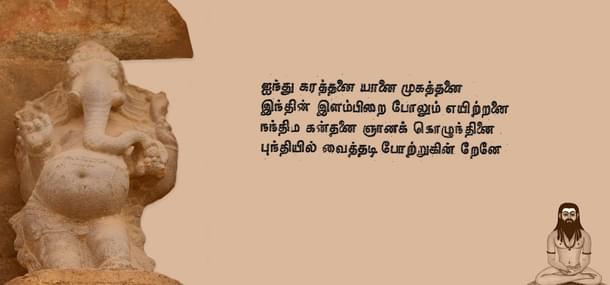
It is a dhyana shloka type hymn that escorts one to meditate in the heart and praise the sacred form of Ganesha, the son of Shiva and the flame of wisdom. He is described as having five hands, elephant-headed and with a crescent moon-like tusk.
Though not an invocation to Ganesha, the verse Pidyathin Uru Umai, by Thirugnana Sambandar (7th century CE) is also considered popularly as an invocation to Ganesha.
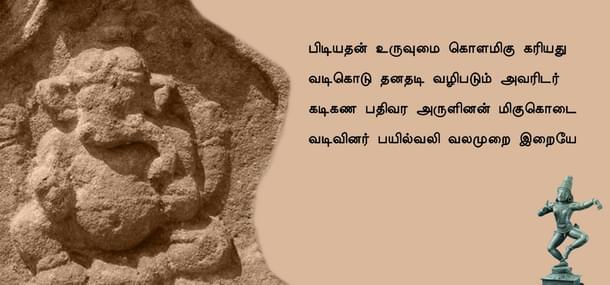
Here, Sambandar refers to the sacred lore of Shiva and Uma taking the form of elephants and from their bliss arises the elephant-headed form of Ganapati.
Perhaps the one who made Ganesha the most beloved child of Tamil Nadu was the saint-poetess Avvaiyaar. The grandmotherly saint travelled all over India. She is distinct from the Sangam age Avvai and probably lived during the medieval period. But in popular memory of Tamil Nadu, all the figures of Avvaiyar merge into one. Her invocation verses are so popular.
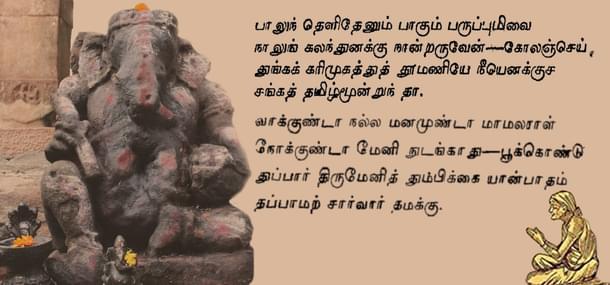
In one of the popular ones she makes a deal with Ganesha. She would give Him four offerings - milk, honey, sugarcane essence, and dal. In return, He should give her only three - expertise in three forms of Tamil.
In another verse she sings what all one will get from Ganesha, - Vak, good mind, auspicious wealth, good health. All one has to do is to worship His sacred feet every day with flowers.
However, the greatest contribution of Avvaiyar was the composition of Vinayagar Agaval- a treatise that elucidates the deepest Yogic mysteries in beautiful and crisp Tamil verses.
Nowhere else has esoteric knowledge been democratised like here. A generation ago, most Tamil children knew the Agaval by heart, and many still do today. More children in Tamil Nadu are introduced to deep spiritual knowledge informally than perhaps anywhere else in the world.
For comparison, a similar non-dualistic spiritual movement by women in Christendom, called the Beguine movement, was ruthlessly suppressed. Its great women mystics, such as Marguerite Porete, who composed The Mirror of the Simple Souls, were burnt at the stake.
Their memory has been so completely erased that their names are remembered only within a small circle of academia. Compared to that text, Vinayagar Agaval took even deeper spiritual knowledge to a larger number of people.
Avvaiyaar was also a bitter critic of social exclusion and rejected the jati system.
To this day she is venerated as a saint, with a temple dedicated to her in Kanyakumari district.
Another significant event in Tamil literary history was when Sri Katchiyappa Sivachariyaar translated the Skanda Purana into Tamil in 10,345 verses, which tradition holds were corrected by Murugan Himself. However, when he presented the text to a learned assembly, Tamil grammarians found the Ganesha invocation to be incorrect.
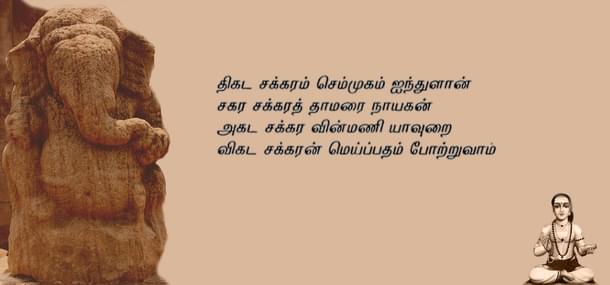
Next day the Lord Himself came in the form of a Pandit and provided a forgotten grammar text to the assembly. This invocation has also become quite famous in the bhakti tradition of Tamil Nadu.
Another popular invocation is Kaithalam Niraikani by a latter medieval saint, Arunagirinathar, found in his Thirupukazh.
He speaks of the great deeds of Ganesha here. He states that Ganesha wrote the essence of the three forms of Tamil in the mountains. This refers to the legend of Ganesha writing the Mahabharata using Himalayan boulders for the palm leaves.
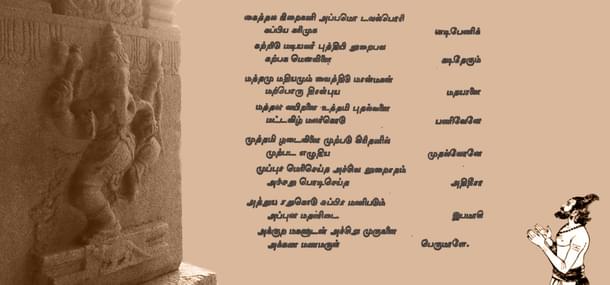
However Arunagiri speaks of Mahabharata as the essence of the three forms of Tamil while it is well known that the epic was written in Sanskrit.
The reason for this is that the essence of three forms of Tamil is Dharma and Mahabharata is the literary expression of Dharma. Thus this verse of Ganesha invocation stresses the cultural and spiritual unity of India.
In modern times, the great Tamil poet Subramanya Bharati wrote Vinayagar Nanmani Malai. The spiritual grandeur of this is second only to that of the Vinayagar Agaval.
This hymn also takes into account the spiritual and material needs of the modern man. So the poet does not ask, but demands, like a son to his father. It is the duty of Ganesha to grant him the boons that he enlists, he says.
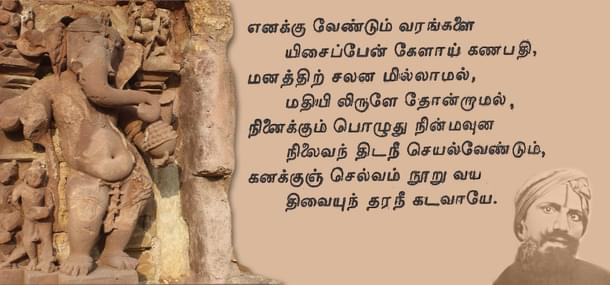
Then comes the list: no disturbance shall ever acquire his mind. No darkness ever enter his intelligence, and whenever he wants, the poet should enter the same state of omniscient cosmic silence in which Ganesha ever abides. That would be the spiritual demands.
But wait Ganesha, 'You also should endow me with heavy loads of wealth and hundred years of life and this is your duty', says Bharati.
To Bharati, all divine forms worshipped by humanity with all different names, are the forms and names of Ganesha.
The dimension of Ganesha being the beloved of children has created quite a few bhajans that treat Him with friendly reverence. In one of the bhajans children love, Ganesha gets on His mouse and travels the world to see the wonders of the modern age. In yet another one composed by Azha.Valliappa, He is the pot-bellied Ganesha.
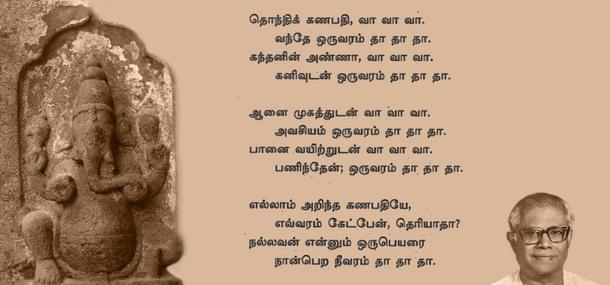
The child calls Him to come and grant the child one boon. 'Don't You know what I am going to ask You pot-bellied Ganapati? Make me a good child. That is all I demand.'
It is hard to imagine any other culture, any other society where the Divine is treated with such wholesome love. Ganesha, with His divine trunk, has elevated Tamil Nadu into the greatest of spiritual heights. Today, it is up to us, the present generation, to continue that legacy and reclaim Tamil Nadu as the land of Dharma.
Aravindan is a contributing editor at Swarajya.




